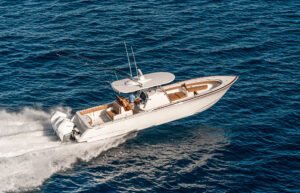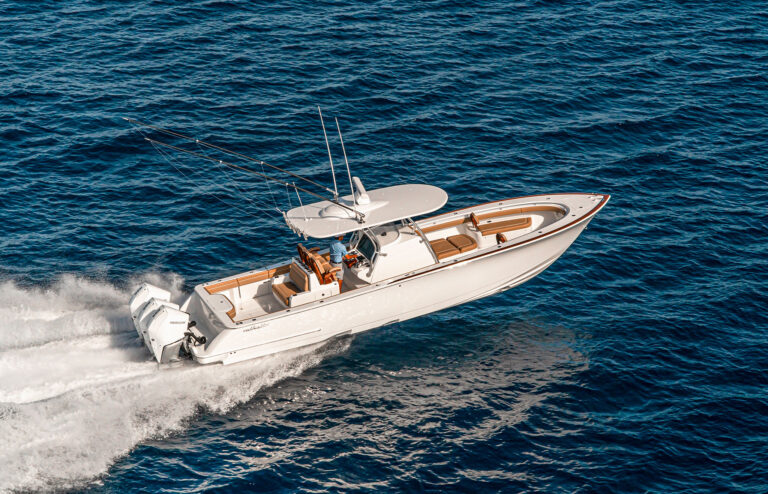
By the time you read this, Kim Russo and Michael Martin will be cruising The Perch, a Silverton 410 Sport Bridge, somewhere in the Great Lakes, loosely following the path of the 6,000-mile-long American Great Loop, navigable water that encircles the eastern half of the U.S. and portions of the Canadian coastline. The couple began their adventure in Ft. Myers, Florida, in the early spring. Having learned Port Lucie Lock on the eastern side of Lake Okeechobee was closed, they chose to begin their trip by heading south for Marathon in the Keys, to round the tip of the Florida peninsula.
Russo has been the director of the American Great Loop Cruisers Association (AGLCA) for seven years and has been involved with the group for about 13 years. A boater for most of her adult life, up until this time she’s enjoyed just portions of the Great Loop during short cruises. Now, she’s enjoying the opportunity to see most of the Loop during an extended, liveaboard adventure.
Martin grew up boating on the Great Lakes, served in the U.S. Navy, and then retired to work with various corporations before joining Curtis Stokes & Associates in Ft. Lauderdale in 2013 as a broker. “For the last 5 to 6 years I’ve been focused entirely on customers whose goals were to do the Loop. Helping folks find a boat for extended cruising has become a passion with me,” he says.
Martin, who has been living aboard The Perch since 2016, is familiar with the Loop. He completed the route, mostly singlehanded. The Perch is a 2001 Silverton 410 Sport Bridge with a modified deep-V hull designed for open water. Still, it is hardly the typical trawler many Loopers run. “Being a broker, I was on and off all kinds of cruisers,” he said. “I’ve sold so many Mainship 390 trawlers that I thought I might wind up buying one. A client asked me to consider the Silverton for him, then decided against it, but the more I studied its features, the more I wanted to buy it personally.”

When he bought the boat in 2016, Martin didn’t have much to change, except the name on the transom, which was Party Girl with a martini glass substituted for the letter Y. He did add a couple of security features, which alert him to increased bilge pump cycling and give him control of deck and interior lighting. And recently, he updated the electronics with a new radar and chartplotter from Raymarine. Still, Martin’s primary navigation tool is a Samsung tablet computer that runs Coastal Explorer and the crowd-sourced Navionics program, which he recommends for its abundance of information, including updates for almost any area where cruisers do their boating.
The couple’s Loop plans are slightly different from other cruisers. “We are both working full-time, and plan to attend AGLCA events along the way, but we never stray too far from an airport so that Michael can meet customers for showings and surveys,” Russo says. “Once we get into the Hudson, we could go up though Lake Champlain and into the St. Lawrence Seaway, or we could head west through the Erie Canal and then north through the Oswego Canal into Lake Ontario, heading for Canada.”
Russo says the boat can’t clear the bridges on the western part of the Erie Canal, but many others can, and it’s been a key piece of the Great Loop for many cruisers. Last year, in fact, it was the only choice because a U.S.-flagged boat could not cruise in Canadian coastal and canal waters, and those who were able to cruise the western portions of the Erie Canal expressed joy and satisfaction about their trips. “This year, we will cruise Canadian waters, including the Trent-Severn Canal, Georgian Bay and the North Channel of Lake Huron,” she says.
“On my first solo Loop, I cruised at 80 to 100 percent throttle,” Martin says. “I also had a $45,000 fuel bill.” At wide-open throttle and 25 knots, the boat’s twin Cummins 450-hp diesels burned 34 gph. He then discovered that the diesels burned just 10 gph running at 10 knots.
“When we’re running at WOT, it feels like we’re shooting $100 bills out the exhausts,” Russo says. “Because the Silverton 410 is more of a motoryacht and designed to cruise well above the 8 to 10 knots many distance cruisers prefer, it’s been interesting to try and find the sweet spot that this boat can achieve and still conserve fuel expenditures.”
The couple has found the sweet spot aboard their Silverton 410, achieving relatively good fuel efficiency while enjoying yacht-style interior spaces. In addition, the Silverton 410 Sport Bridge has proved its mettle across a wide range of open water and river systems. Russo and Martin are sure to have a wonderful cruise.
Walkthrough
After years of building yachts with conventional styling, Silverton invested the 410 Sport Bridge with a new look featuring Euro-style exterior design influences. Among them are molded staircases that lead up to the spacious flybridge from the aft cockpit and then down and forward to the foredeck. As a result, the sidedecks are raised, which allowed the builder to push the sides of the salon out to the gunwales for an especially spacious interior. There’s a galley up to port and a dinette to starboard—both are far forward and set near the windshield for outstanding views. On the accommodations level, there is a master stateroom amidships, a guest cabin in the bow and a shared head compartment to starboard. Powered by twin gas or diesel engines, the Silverton’s modified deep-V hull has 16-degrees of deadrise at the transom for good performance across a wide range of speeds and conditions.
BACKGROUND
According to The PowerBoat Guide by Ed McKnew, a reference guide to new and used production boats produced as far back as 1975, the Silverton 410 Sport Bridge was manufactured from 2001 to 2004. It spoke volumes about the way the builder had grown and changed.
Back in the late 1960s, when fiberglass was changing the face of production boatbuilding, Silverton built its Sea Skiffs in Toms River, New Jersey. The company was later renamed Silverton Marine and moved to Millville, New Jersey, in 1985. There, the company grew into a major builder of motoryachts, sedan cruisers and convertibles. The company was in business for almost three decades before closing its doors in 2012.
Would you like to see your boat in Soundings?
We’re looking for boats and owners to feature in this department.
If you want to share your story, contact the editorial team at [email protected].
This article was originally published in the July 2022 issue.










